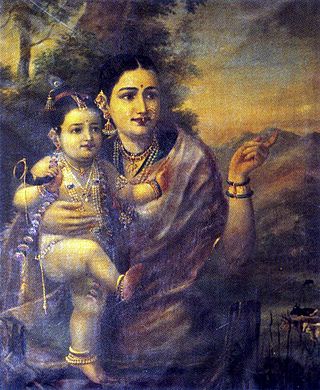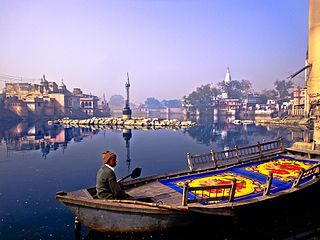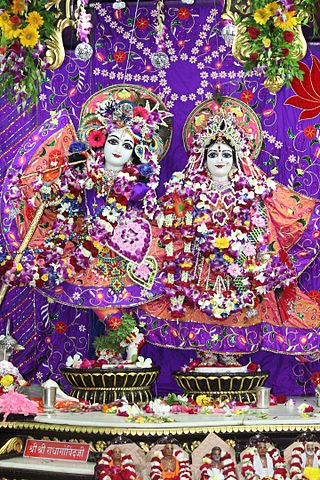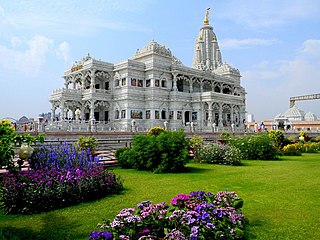
Radha, also called Radhika, is a Hindu goddess and the chief consort of the god Krishna. She is worshiped as the goddess of love, tenderness, compassion, and devotion. She is the avatar of goddess Lakshmi and is also described as the chief of the Gopis (milkmaids). During Krishna's youth, she appears as his lover and companion. Many traditions and scriptures accord Radha the status of the eternal consort and wife of Krishna. Radha, as a supreme goddess, is considered as the female counterpart and the internal potency of Krishna, who resides in Goloka, the celestial abode of Radha Krishna. Radha is said to accompany Krishna in all his incarnations.

The International Society for Krishna Consciousness (ISKCON), known colloquially as the Hare Krishna movement or Hare Krishnas, is a Gaudiya Vaishnava Hindu religious organization. ISKCON was founded in 1966 in New York City by A. C. Bhaktivedanta Swami Prabhupada.

Śrāvaṇa is the fifth month of the Hindu calendar. In India's national civil calendar, Śrāvaṇa is the fifth month of the year, beginning on July 23 and ending on August 22. In the Tamil calendar, it is known as Āvani and is the fifth month of the solar year. In lunar religious calendars, Śrāvaṇa begins on the new moon or the full moon and is the fifth month of the year. Srabon is the fourth month of the solar Bengali calendar. It is also the fourth month of the Nepali calendar. Śrāvaṇa is also the second month of Varsha.

Krishna Janmashtamilit. ''Occasion of the birth of Krishna'', also known simply as Krishnashtami,Janmashtami, or Gokulashtami, is an annual Hindu festival that celebrates the birth of Krishna, the eighth avatar of Vishnu. According to the Hindu lunisolar calendar, it is observed on the eighth tithi (Ashtami) of the Krishna Paksha of Shraavana Masa or Bhadrapada Masa. This overlaps with August or September of the Gregorian calendar.

Vrindavan, also spelt Vrindaban and Brindaban, is a historical city in the Mathura district of Uttar Pradesh, India. It is located in the Braj Bhoomi region and holds religious importance in Hinduism as Krishna spent most of his childhood days in this city. Vrindavan has about 5,500 temples dedicated to the worship of Krishna and his divine consort Radha.
Mayapur is a neighbourhood of Bamanpukur, in the Nabadwip CD block in the Krishnanagar Sadar subdivision of the Nadia district in the state of West Bengal, India. It is situated adjacent to Nabadwip, at the confluence of two rivers, where the waters of the Jalangi River mix with Bhagirathi, a distributary of the Ganges. It is located about 130 km north of Kolkata. Along with Nabadwip, it is considered a spiritual place by the adherents of Gaudiya Vaishnavism.

Dola Purnima, also popularly known as Dolo Jatra, Doul Utsav or Deul, is the major Holi festival of Braj region, Bangladesh and the Indian state of Odisha, Assam, Tripura and West Bengal. This festival is dedicated to the divine couple of Radha and Krishna. It is usually celebrated on the full moon night or fifteenth day of the Falgun month mainly by Gopal community.

Mathura district situated along the banks of the river Yamuna is a district of Uttar Pradesh state of north-central India. The historic city of Mathura is the district headquarters. Mathura district is home to many important sites associated with goddess Radha and Krishna, who is believed to be born in Mathura and grew up in the nearby town of Vrindavan. Both cities are some of the most sacred sites in the Vaishnava tradition, making Mathura district an important Hindu pilgrimage centre.

Radha-Krishna are collectively known within Hinduism as the combined forms of feminine as well as the masculine realities of God. Krishna and Radha are the primeval forms of God and his pleasure potency, respectively, in several Vaishnavite schools of thought.

Shri Swaminarayan Mandir, Mumbai is a Hindu temple (Mandir) and a part of the Swaminarayan Sampraday. This Swaminarayan Temple is located in the Bhuleshwar area of Mumbai and is the oldest Swaminarayan Mandir in Mumbai, being over a hundred years old.

Kartika Purnima is a Hindu, Sikh and Jain cultural festival that is celebrated on Purnima, the 15th lunar day of the month of Kartika. It falls in November or December of the Gregorian calendar and is also known as Tripurari Purnima or Deva-Deepawali, the gods' festival of lights. Karthika Deepam is a related festival that is celebrated in South India and Sri Lanka on a different date.

Govardhan Puja, also known as Annakut or Annakoot, is a Hindu festival in which devotees worship Govardhan Hill and prepare and offer a large variety of vegetarian food to Krishna as a mark of gratitude. For Vaishnavas, this day commemorates the incident in the Bhagavata Purana when Krishna lifted Govardhan Hill to provide the villagers of Vrindavan shelter from torrential rains. The incident is seen to represent how God will protect all devotees who take singular refuge in him. Devotees offer a mountain of food, metaphorically representing the Govardhan Hill, to God as a ritual remembrance and to renew their faith in taking refuge in God. The festival is observed by most of Hindu denominations all over India and abroad.

Banke Bihari Temple is a Vaishnava Hindu temple situated in the town of Vrindavan, Mathura district of Uttar Pradesh, India. The temple is dedicated to Banke Bihari who is believed to be the combined form of Radha and Krishna. Banke Bihari was originally worshipped at Nidhivan, Vrindavan. Later, when Banke Bihari temple was constructed around 1864, the icon of Banke Bihari was moved to new temple.

Sri Sri Krishna Balaram Mandir, also called ISKCON Vrindavan, is one of the major ISKCON temples in the world. It is a Gaudiya Vaishnava temple located in the city of Vrindavan, Mathura district, in the Indian state of Uttar Pradesh. The temple is dedicated to the Hindu gods Krishna and Balarama. The other deities of temple are Radha Krishna and Gauranga Nityananda.

Sri Radha Krishna-chandra Temple is one of the largest Krishna-Hindu temples in the world. It is situated in Bangalore in the Indian state of Karnataka. The temple is dedicated to Hindu deities Radha Krishna and propagates Monotehism as mentioned in Chandogya Upanishad.

Prem Mandir is a Hindu temple in Vrindavan, Mathura district, Uttar Pradesh, India. The temple was established by Jagadguru Shri Kripalu Ji Maharaj. It is maintained by Jagadguru Kripalu Parishat, an international non-profit, educational, spiritual, charitable trust. The complex is on a 55-acre site on the outskirts of Vrindavan. It is dedicated to Radha Krishna and Sita Ram. Radha Krishna are on the first level and Sita Ram are on the second level. Different Leelas of Shri Krishna and Rasik saints are depicted all over the wall of the main temple.
Shri Dwarkadheesh Mandir is one of the oldest and largest Hindu temples of Mathura city in state of Uttar Pradesh, India. The current structure of temple was built up by Seth Gokul Das Parikh, the treasurer of then Gwalior State (Scindia) in 1814, with approval and donation from Shrimant Daulatrao Scindia, Maharajah of Gwalior. In this historic temple, Lord Krishna is worshipped in his Dwarkanath or Dwarkadhish form along with his counterpart goddess Radha in form of Radharani.

Shri Radha Rani Temple, also called Shriji (Shreeji) Temple and ShriLaadli Lal Temple, is a historical Hindu temple, located in Barsana in Mathura district, Uttar Pradesh, India. The temple is dedicated to the goddess Radha. The main deities of the temple are Radha Krishna who are worshipped together in the form of Shri Laadli Lal which means beloved daughter and son of the town.

Shri Radha Vallabh Temple, also called Shri Radha Vallabhlal ji Temple is a historic temple in the city of Vrindavan, Mathura district, Uttar Pradesh, India. The temple is dedicated to Hindu deities Radha Krishna. The central deity of the temple is Krishna who is worshiped under the name of Shri Radha Vallabh which means the consort of Radha. Alongside Krishna, a crown is placed which signifies the presence of goddess Radha. The temple belongs to Radha Vallabh Sampradaya and was constructed in 16th century under the guidance of Vrindavan saint Hith Harivansha Mahaprabhu.

















